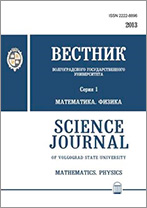|
|
Vestnik Volgogradskogo gosudarstvennogo universiteta. Seriya 1. Mathematica. Physica, 2014, Issue 4(23), Pages 11–35
(Mi vvgum58)
|
 |
|
 |
This article is cited in 1 scientific paper (total in 1 paper)
Mathematics
On dimensions of affine transformation groups transitively acting
on a real hypersurfaces in $\Bbb C^3$
A. V. Loboda
Voronezh State Academy of Building and Architecture
Abstract:
The main content of the article constitute the three theorems related to
the dimensions of homogeneous manifolds.
Traditionally we mean homogeneity as the existence of a local Lie group,
that acts transitively on the manifold under consideration near
a selected point.
As acting groups, in affine homogeneity case only a subgroups of the group Aff $ (3, \Bbb C)$ are
considered.
The main instruments of the article are the affine canonical
equations for the studied homogeneous surfaces and the Lie algebras of
affine vector fields tangent to these manifolds.
The concept of affine homogeneity
is closely related, in the case of
real hypersurfaces, to holomorphic homogeneity,
that is natural for
multidimensional complex analysis.
But even for the hypersurfaces of $3$-dimensional complex spaces
the classification problems in both cases (affine and holomorphic)
do not arise until the complete solution.
One of the things that could help to obtain
such a solution is to understand the situation with possible
dimensions of a Lie groups (and Lie algebras) which acts transitively
on the homogeneous manifolds under consideration.
In this paper the dependence is studied of such dimension
from a couple of the Taylor coefficients of the $2$-nd order
(specifying the type of surface) of the canonical equation of
strictly pseudo convex (SPC) hypersurface.
In this article we obtain (in Theorem 1) a general estimate for the
dimension of such groups for an arbitrary strictly pseudo convex
affinely homogeneous hypersurfaces in complex space $ \Bbb C^3 $.
For one of the several types of homogeneous surfaces, this estimate is sharp:
the affine transformation group with the maximal possible dimension $10$
acts transitively
on the quadric $ Im \, w = | z_1 |^ 2 + | z_2 |^ 2 $.
For affinely homogeneous surfaces, that are not equivalent to this quadric,
the dimension of such affine group does not exceed $7$.
The proof of this statement is given in the article
(in Theorem 2) for the surfaces of the type $(1/2, 0)$.
To prove this assertion we use the coefficients
structure of affine vector fields tangent to homogeneous surfaces.
The description of this structure is also obtained in the paper.
In Theorem 3, the describing problem for the affine homogeneous surfaces
of the type $(1/2,0)$ with «rich» symmetry groups in space $ \Bbb C^3 $
is reduced to the study of only $5$-dimensional Lie groups and algebras.
Note that in the general context of the homogeneity problem
such a reduction is not possible; here the
specificity of the studied type of the surfaces plays the crucial role.
Note that a complete description of affinely homogeneous hypersurfaces
of the type $(1/2, 0)$ in the space $ \Bbb C^3 $
with $5$-dimensional algebras of tangent vector fields is
presented in a joint paper of the author (ArXiv.org, 2014).
Because of the sufficiently large dimensions the scheme of the
homogeneous varieties description, as well as this article considerations,
imply significant use of computer symbolic calculations.
Keywords:
affine transformation, homogeneous manifold, vector field, Lie algebra, canonical equation of surface.
Citation:
A. V. Loboda, “On dimensions of affine transformation groups transitively acting
on a real hypersurfaces in $\Bbb C^3$”, Vestnik Volgogradskogo gosudarstvennogo universiteta. Seriya 1. Mathematica. Physica, 2014, no. 4(23), 11–35
Linking options:
https://www.mathnet.ru/eng/vvgum58 https://www.mathnet.ru/eng/vvgum/y2014/i4/p11
|

| Statistics & downloads: |
| Abstract page: | 184 | | Full-text PDF : | 98 | | References: | 44 |
|




 Contact us:
Contact us: Terms of Use
Terms of Use
 Registration to the website
Registration to the website Logotypes
Logotypes








 Citation in format
Citation in format 
